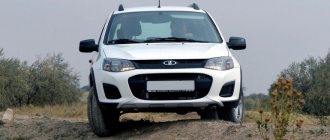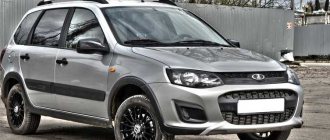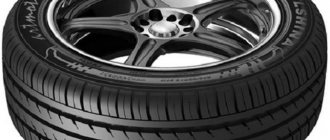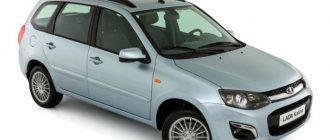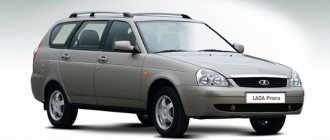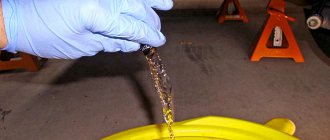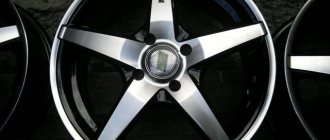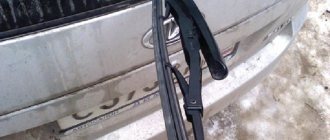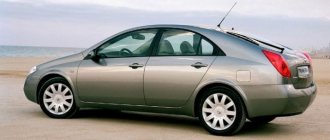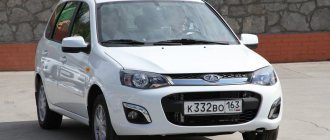Lada Kalina wheel, rim and tire sizes
Lada Kalina is a front-wheel drive car representing the small class. The model replaced AvtoVAZ's budget products with rear-wheel drive. Its production has been carried out in Tolyatti since 2004.
The main competitors of the Lada Kalina model are Daewoo Gentra, Chevrolet Cobalt, Chery Amulet and Lada Granta. In terms of price characteristics, these cars are comparable. Lada Kalina boasts greater maneuverability and smaller dimensions, which allows it to move more confidently in cramped city conditions.
This model has the advantages and disadvantages characteristic of most AvtoVAZ products. The advantages of the car are a wide variety of trim levels, a rigid body, reasonable price, spacious interior and good visibility. The disadvantages include an excessively noisy transmission, low noise insulation in the cabin and not the highest reliability.
Generation 1
The development of the Lada Kalina model began in 1993. In 1998-2000, AvtoVAZ showed prototypes of the car. The official premiere of the product took place only in 2004.
The basic version was the VAZ-1118 sedan. Its production continued until 2009, after which it gave way to the Lada Granta. Since the development of the first generation Lada Kalina lasted almost 10 years, its appearance turned out to be similar to foreign cars of the late 1990s. However, the sedan did not look at all like a “guest from the past.”
The exterior of the model looked quite good against the background of domestic cars. True, in the profile of the VAZ-1118 there was clearly a noticeable disproportion between the short, high stern and the small, low hood. The sedan did not create a feeling of heaviness, but it looked too miniature.
Small headlights and a radiator grille taken from Priora complemented the image of the city car.
The interior of the VAZ-1118 turned out to be very comfortable using modern materials. The compactness of the car should not be confusing; 5 people could comfortably fit inside it. The trunk of the Lada Kalina sedan was designed for 400 liters.
The model was equipped exclusively with a 1.6-liter unit (80 hp), corresponding to Euro-3.
The hatchback of this series was introduced in 2006. The VAZ-1119 model existed for seven years. The car became a complete copy of the sedan, differing from it only in its shortened length. Such changes affected the free space in the cabin and trunk volume. The Lada Kalina hatchback was positioned exclusively as a city car, and its compactness was seen as a plus, as it allowed it to maneuver on narrow streets. Externally, it looked lighter and faster in comparison with the sedan. In addition to the 1.6-liter engine, the hatchback was equipped with a 1.4-liter unit.
The latest modification of the Lada Kalina was the VAZ-1117 station wagon. It arrived at dealers in 2007. The model had a longer body and increased ground clearance by 25 mm. This allowed her to move more easily on country roads. The remaining technical characteristics of the station wagon completely repeated those of the sedan.
Wheel sizes
For all modifications of the model, the following types of wheels and tires were used:
- wheels 5J on 13 ET40 (5 – width in inches, 13 – diameter in inches, 40 – positive offset in mm), tires – 175/70R13 (175 – tire width in mm, 70 – profile height in %, 13 – rim diameter in inches);
- 5.5J wheels on 14 ET37, tires – 175/65R14;
- 6J wheels on 14 ET37, tires – 185/60R14;
- 6.5J wheels on 15 ET35, tires – 195/50R15;
- 6.5J wheels on 16 ET45, tires – 195/45R16.
Other wheel characteristics:
- PCD (drilling) – 4 by 98 (4 is the number of holes, 98 is the diameter of the circle on which they are located in mm);
- fasteners – M12 by 1.25 (12 – stud diameter in mm, 1.25 – thread size);
- diameter of the central hole – 58.6 mm;
- tire pressure – 1.9 bar.
In 2011, Lada Kalina became a leader in terms of sales volumes on the Russian market. In comparison with other AvtoVAZ models, it was a step forward in technical terms and in design.
Generation 2
In 2013, the second generation of Lada Kalina appeared. The car premiered at the Moscow Motor Show a year earlier. After 9 years of producing the debut generation, AvtoVAZ decided to refresh the model, making it more modern. As a result, Lada Kalina II received a new design, a revised range of engines and transmissions, a redesigned interior and a suspension with improved settings.
The eyeliner did the model good. The car has become more dynamic and increased in size. The second Lada Kalina is no longer a miniature city car, but a full-fledged class B hatchback. In this series, AvtoVAZ refused to produce modifications in the sedan body, offering consumers exclusively station wagons and hatchbacks. Other changes include revised front optics and an enlarged mesh grille. The openings for the foglights were also significantly enlarged.
The transformations also affected the interior. The interior of the new Lada Kalina has received higher quality finishing materials. Minor changes affected the center console. In the basic configuration, the list of equipment has become richer.
At the minimum, the car acquired front electric windows, 1 airbag and ABS. This version received a 1.6-liter 8-valve unit (87 hp). More top-end variations were equipped with a 1.6-liter 8-valve engine (98 hp) and a 1.6-liter 16-valve engine (106 hp). A “sport” version with a 118-horsepower unit was also offered. The power plants came in combination with an “automatic” or “mechanical”.
Wheel and tire characteristics:
- 5.5J wheels on 14 ET35, tires – 175/65R14;
- 6J wheels on 14 ET35, tires – 185/60R14;
- 6J wheels on 15 ET35, tires – 185/55R15;
- 6.5J wheels on 15 ET35, tires – 195/50R15;
- 6.5J wheels on 16 ET35, tires – 195/45R16.
In 2014, AvtoVAZ introduced a cross-country version of the Lada Kalina.
Source: https://avto-razmer.com/lada-kalina-razmer-koles-diskov-shin.html
What is the bolt pattern of the wheels on Kalina?
- Lada Kalina wheel size: tires, wheels, bolt pattern
- Tire and wheel sizes for Lada Kalina (2004-2018) Lada Kalina I (2004 – 2013)
- Find the disk parameters of Lada Kalina (2192) 2013, 1.6 (87 hp, gasoline).
Lada Kalina owners often wonder what kind of wheels and tires are suitable for this car? In this case, the manufacturer provided an answer to this question and compiled a list of possible options for installing different wheel and tire options on Kalina. But the bolt pattern also plays a big role.
What non-standard sizes can be supplied?
Non-standard sizes of winter and summer tires are acceptable on the Lada Kalina, if you choose them correctly among the entire range provided. At the moment, manufacturers have tried to expand the boundaries of their offerings in order to prove themselves to potential customers. The following options for non-standard winter and summer tires are distinguished:
- The R16 is a large diameter wheel, which raises the car's suspension slightly, resulting in a soft and smooth ride.
- Small radii are an opportunity to lower the vehicle, while emphasizing its practicality, but it is not recommended to use the car at such a low “landing” in impassable terrain, since there is a possibility of damage to the front and rear bumpers.
Summer tires differ from winter tires in that they remain stable on the track, despite the increased temperature of the surface, which heats up the rubber and can cause it to stick to the surface. In winter, it is important to ensure good grip on slippery roads, while preventing the car from skidding on a poorly cleaned road surface.
Recommended tire and wheel sizes for Lada Kalina 2 (hatchback and station wagon)
July 22, 2015 Lada.Online 263 287
Tire size is an important parameter that affects the behavior of a car on the road. In the review we will tell you about the size of tires and wheels of the 2nd generation Lada Kalina allowed by the manufacturer. We will also consider what these parameters influence during operation.
Acceptable sizes of tires and wheels VAZ 2192, 2194
The manufacturer indicated the tire and wheel sizes in the user manual.
On the “Standard” and “Norma” configurations, the manufacturer installs:
- 175/65R14 82H
- 185/60R14 82H
Rim width: 51/2J, disc offset (rim, ET): 35 mm, DIA: 58.5, bolt pattern: 4x98.
For the “Lux” package, the manufacturer installs:
- 175/65R14 82H
- 185/60R14 82H
- 185/55R15 82V
The factory installs the Lada Kalina 2 sport:
- 185/55 R15
- 195/50 R15
- 195/50 R16
- 205/40 R17
Standard tire sizes for Lada Kalina Cross:
R is not a radius, but a designation of the radius of the tire, and the number is the diameter of the rim in inches.
Rim width: 5J, 51/2J and 6J, disc offset (rim, ET): 35 mm, DIA: 58.5, bolt pattern: 4x98.
AvtoVAZ allows the installation of tires and wheels from one configuration of the Lada Kalina 2 to another and vice versa.
Tire and Wheel Compatibility
Tuning enthusiasts are concerned about the question of what kind of alloy wheels can be installed on Kalina so that the wheels do not touch the fender liners and the speedometer does not lie. When choosing new “rollers”, take into account the full diameter of the wheel; it should not differ much from the standard one. You can understand which tires are suitable using the compatibility table. The left one is built on 185/60 R14 (minimum diameter), the right one - 185/55 R15 (maximum diameter):
Green indicates the minimum deviation of the wheel diameter (up to 3 mm); Orange indicates a diameter deviation from 3 to 6 mm.
Thus, you can install wheels on Lada Kalina 2:
- 175/70 R13, 185/70 R13, 195/65 R13, 205/60 R13, 215/60 R13, 225/55 R13;
- 175/65 R14 , 185/60 R14 , 195/60 R14, 205/55 R14, 225/50 R14;
- 175/55 R15, 185/55 R15 , 195/50 R15, 205/50 R15, 215/45 R15, 225/45 R15;
- 185/50 R16, 185/45 R16, 195/45 R16, 215/40 R16, 225/40 R16;
- 175/45 R17, 175/40 R17, 185/40 R17, 195/40 R17.
We advise you to choose only those tires that AvtoVAZ recommends (they are highlighted in bold in the list).
Don't forget about the rim width:
When installing tires or wheels that differ in parameters
from those recommended by the factory, you can:
- be refused warranty repair of the chassis;
- be stopped by a traffic police inspector, who has the right to draw up a report on the car’s non-compliance with the requirements of the Technical Regulations;
- fail to pass technical inspection.
What does the size of tires and wheels affect?
Increasing the diameter of the disk Increasing the width of the disk Increasing the width of the tire
| Car style | will improve | will improve | will improve |
| Road holding | will improve | will improve | will improve |
| Steering precision | will improve | will improve | will improve |
| Tire grip | Will not change | Will not change | will improve, but only on dry roads |
| Resistance to hydroplaning | Will not change | Will not change | will get worse |
| Comfort on rough roads | will get worse | Will not change | will improve |
| Road noise | Will not change | Will not change | will intensify |
| Gasoline consumption | Will not change | will increase | will increase |
| Tire wear | Will not change | Will not change | will increase |
Have you decided to choose winter tires for Lada Kalina 2? For winter it is recommended to choose narrow tires. The fact is that with such tires the pressure on the road surface will be greater, and therefore the grip on the road will improve. Wide tires are more sensitive to ruts in winter. Low-profile tires perfectly transfer even the smallest pits to the fifth point.
The smaller the unsprung masses
(this includes a lot of tires and wheels), the better the car will hold the road and accelerate faster. For example, if you put wheels on a car that are 2 kg lighter each, then acceleration to 100 km/h will be reduced by 0.2 seconds.
Choosing the best brand of winter tires
For Lada Kalina, 3 tire variations are installed from the factory. The best among them, according to reviews from those who have already used a car, are Nikon - tires from a famous Finnish manufacturer. This will be the optimal choice for any configuration of Kalina, be it with a diesel or gasoline engine up to a volume of 1.6 liters (only such variations are installed from the factory, but modification remains possible). Winter tires like BridgeStone can be called higher quality and more reliable, but not rational in terms of cost. They are almost 3 times more expensive for a regular set of Nikon tires, but in practice they do not work out for their value.
Still, it must be taken into account that the Lada Kalina will mainly be used on Russian roads in extremely harsh conditions. And here the use of too “delicate” rubber, for example, from the Nordman company, will not work (although there are several decent options there). Yes, it is reliable and of high quality, providing optimal control characteristics. However, as a consumer it is not the best option.
By the way, one thing that can be mentioned in favor of Nikon is that here the tire sizes for the same model vary over a wide range, so there will definitely not be any problems with the choice. But you shouldn’t buy universal tires that can act as both summer tires and winter tires. In practice, it has been repeatedly proven that under harsh operating conditions it wears out in literally 0.5 seasons.
Therefore, saving is inappropriate here. Still, you should keep two sets of Kalina in your garage at once - for winter and summer. Rain is not necessary, since for a car of this class it has practically no advantages, and the hub still wears out unevenly for the most part due to numerous potholes on the roads.
If you don’t want to stop at Nikon, it’s better to pay attention to the Gislaved brand. Despite the fact that we are talking about Chinese production, its quality is not inferior to foreign analogues from Finland.
Still, the “Made in China” label no longer indicates low quality products, and this is a fact.
And for those who prefer products in the mid-price category, we can offer winter tires from Nord: a fairly low price and resistance to dynamic loads allow the manufacturer to boast of the wear resistance of the rubber used. True, prices for these products have not been very encouraging lately, but this can only be explained by the jump in the ruble exchange rate.
What about taller tires? Larger tires can indeed improve a car's performance, but keep in mind that the wheel itself will be more vulnerable to aggressive driving, especially on broken asphalt.
We can also mention Kleber winter tires, but they are expensive. But they are very durable. They will easily withstand 4 seasons, maintaining the original tread pattern. But, according to reviews, they are prone to skidding at high speeds. Although this can be adjusted by tire pressure, there is no point in using them.
tweet
back Why Lada Kalina won't start
Next Test drive the Lada Kalina station wagon
Tagschoice, manufacturer, tires
Lada Kalina 1 and 2 tire size and bolt pattern
Every Lada Kalina owner sooner or later faces the need to replace wheel rims. When you want to give the exterior of your “horse” a more attractive appearance, then you should take a closer look at the cast versions of the products. How practical is this? We will try to answer this question, which concerns a huge army of owners of products from the Russian automotive industry; it is also important to know that if you install other wheels, you will need a bolt pattern. We’ll also figure out what aspects you need to focus on when choosing, and what is the best tire size.
Standard disks and their parameters
Representatives of the first generation Lada Kalina were equipped with stamped versions of wheels with dimensions of 13-14 inches. Then light alloy options saw the light. They had a diameter of 14 inches.
When owners deliberately strive to lower the tire profile, they immediately betray themselves with a desire to install larger rims. For Kalina, you can use 15-inch options, which is what the manufacturer does in its sports modifications, but other options will require a bolt pattern.
All body versions of the Lada Kalina in the first generation (2003-2014), from civilian to sports versions, were equipped with the following list of wheels available from the manufacturer:
- products "5J" to "13 ET40"; with them we can use the wheel size “175x70xR13”;
- “5.5J” on “14 ET37”, the manufacturer included tires “175x65xR14” in the kit;
- options “6J” on “14 ET37” has wheel size “185x60xR14”;
- “6.5J” wheels on “15 ET35”, the wheel size “195x50xR15” goes well with them;
- “rollers” “6.5J” on “16 ET45”; everything is serious here, because the tire size “195x45xR16” turns the Lada Kalina tires into real “bast shoes”.
Body modifications of the domestic model in the second generation (after 2014) were awarded the following wheel options and tire sizes like them:
- “5.5J” on “14 ET35”, where we find tires “175x65xR14”;
- go to options “6J” to “14 ET35”; they imply cooperation with “185x60xR14” tires;
- product versions “6J to 15 ET35”, tires “185x55xR15”;
- “6.5J” wheels on “15 ET35”, “195x50xR15” tires work with them;
- flagships “6.5J” on “16 ET35”; such wheels “are not ashamed to put on” tires, and the tire size is “195x45xR16”.
Interesting moment! The “Norma” and “Standard” versions, which the manufacturer produced during the entire time the second generation Kalina was on the assembly line, are deprived of standard light-alloy products. The “luxury” Lada Kalina is able to please its buyer with such wheel options, especially since the developers here have provided the opportunity to choose between the “R14” and more respectable “R15” versions.
What disks are suitable as an alternative to the standard versions?
It's time to change the “original” wheels. The main thing here is not to overdo it, but to choose products that are as similar in design and geometric aspects as possible to the standard options. Note that the wheel parameters “don’t care” what body is in front of them (sedan or etc.).
To make the right selection, you will need to gain valuable knowledge such as:
- the quantitative composition of the holes for the mounting bolts and the diameter of the circle, the conditional line of which passes through the centers of the indicated holes (“LZ*PCD”, for Kalina - “4*98”);
- diameter of the central hole of the disk (“DIA”); for disks of this model it is equal to 58.6 mm (coincident with the hub diameter with tolerance);
- the offset value (or “ET”), which varies in values (to be specified later).
Let's summarize here.
1. The first generation of LADA Kalina in versions “1117”, “1118” and “1119” can be equipped with wheel versions from 13 to 16 inches with the following parameters:
- bolt pattern - 4*98;
- width – from 5 to 6.5 (inches);
- departure – from 25 to 35.
2. The second generation “2192” and “2194” will be content with wheels from 14 to 16 inches with the following characteristics:
- “LZ*PCD” similar parameter (4*98);
- width – from 5.5 to 6.5;
- offset: 25 – 35;
- the hole diameter is identical at 58.6 mm.
It should be remembered that correctly selected wheels will allow you to achieve traffic safety, moderate fuel consumption, and also increase the service life of the suspension.
Stamped and cast: which is better?
According to the production method, wheels for LADA Kalina are divided into two global categories: stamped (from steel sheet) and light alloy (forged, cast or combined).
For the first option, manufacturing involves welding individual structural elements of the product. The technology is simple, which has a positive effect on the cost of disks.
Among the advantages of “stampings” we note:
- reliability;
- maintainability (tendency to eliminate bent areas);
- durability.
Negative aspects:
- it is difficult to perform auto-balancing;
- significant mass of products;
- lack of design possibilities (same type);
- low corrosion resistance.
Now let's touch on light alloy options. Such discs are more progressive products that are made from light metal alloys such as magnesium and aluminum, etc.
When choosing the kit you like, we recommend paying attention to the indication of the primary metal included in the material structure.
If magnesium dominates, then the discs are light in weight, but the strength properties of this option are far from ideal. Aluminum gives the product strength and fluidity. This translates into good resistance to cracking under impact loads. Wheel alignment will also likely be required.
Lada Granta overall dimensions
Lada Granta station wagon
Covers Lada Granta
To give preference to any of the above options, we recommend that you undertake an approximate analysis of the condition of the roads on which your LADA Kalina will travel in the future.
Advantages of "casting":
- availability of a wide range of models;
- light weight, which has a positive effect on handling and dynamics;
- good dissipation of heat generated by brake units.
